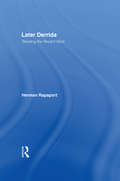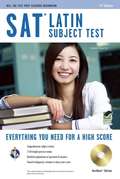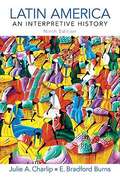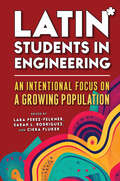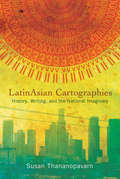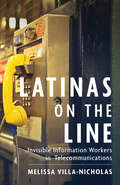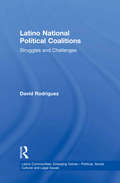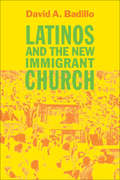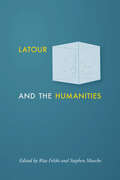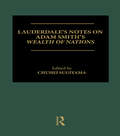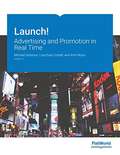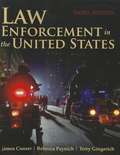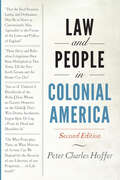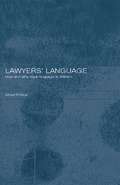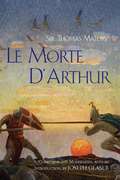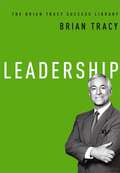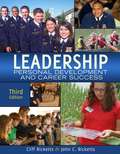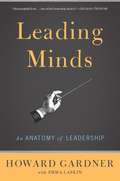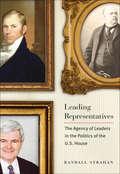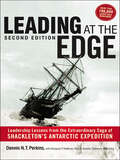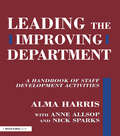- Table View
- List View
Later Derrida: Reading the Recent Work
by Herman Rapaport"First Published in 2002, Routledge is an imprint of Taylor & Francis, an informa company."
Latin (SAT PSAT ACT (College Admission) Prep Series)
by Ronald B. Palma<P>Taking the SAT Latin Subject Test? <P>Then REA's SAT Subject Test: Latin Test Prep with Practice Tests on CD is just for you! <P>Written by an experienced Latin teacher, this second edition of our bestselling SAT Subject Test: Latin test prep includes a comprehensive review of covers all language areas appearing on the actual exam including coverage of declensions, conjugations, sentence structure, and more. Each chapter contains numerous examples and practice questions, and tips that help students study smarter and boost their test scores. <P>The book includes two full-length practice tests that replicate the actual exam's question format. Both of the book's practice exams are featured on our TestWare CD with the most powerful scoring and diagnostic tools available today. Automatic scoring and instant reports help you zero in on the topics and types of questions that give you trouble now, so you'll succeed when it counts. <P>Detailed explanations of answers help you identify your strengths and weaknesses. We don't just say which answers are right - we also explain why the other answer choices are incorrect - so you'll be prepared on test day. <P>The book also includes study tips, strategies, and confidence-boosting advice you need for test day. <P>REA's test prep is a must for any high school student taking the SAT Latin Subject Test!
Latin America: An Interpretive History (Ninth Edition)
by Julie A. Charlip E. Bradford BurnsFor courses in the History of Latin America and Modern Latin America. Organized thematically, this text offers a clear narrative that weaves the story of Latin America together with coverage of broader themes and regional differences. In addition to the great diversity within Latin America, there is also a common theme that encompasses the sweep of history in the region. The original author of the text, E. Bradford Burns, cast the problem as the paradox that poor people inhabit rich lands. The reason for this paradox is that a tiny group of elites confuses their nation's well-being with their own. When this text was first published in 1972, there were very few texts on Latin America, and the ones that existed largely read like catalogs of historical events. Although there are others now, this textbook is still a leader in the field because of its clear thematic organization and a central narrative that tells a cohesive story, albeit with many variations. Co-author Julie A. Charlip is committed to continuing the Burns legacy. Despite changes in research, interpretations, and theories, Burns's basic premise is still the most accurate and succinct, providing the best framework for approaching the region.
Latin* Students in Engineering: An Intentional Focus on a Growing Population
by Taryn Ozuna Allen Christine Hall Diana Garza Michael Perez Tonisha B. Lane Maria L Espino Morgan Nichols Brian D Le Blanca Rincón René Hernandez Erin Doran Elizabeth Turochy Cristina Poleacovschi Timothy Yuen Dina Verdín Renata Revelo Janice Mejía Da'Shay Portis Templeton Hector E Rodriguez-Simmonds Leonardo Pollettini Marcos Cristián Vargas-Ordóñez Kevin Jay Kaufman-Ortiz Selyna Pérez Beverly Lisa R Lattuca Courtney Matthews Lisette E Torres Krystal Peralez Elsa Gonzalez Emma Claudia Perez Adriana Facundo Ulises Trujillo Garcia Esther EnrightThe growing population of engineering students who identify as Latin* are underrepresented in the field of engineering. Latin* refers to an individual of Latin American origin or descent, without restricting to a specific gender. The asterisk (*) includes related identity terms such as Latina/é/o/u/x.There is, however, a rising need to train U.S. students in engineering skills to meet the demands of our increasingly technological workforce. Structurally excluding Latin* students hinders their economic and educational opportunities in engineering. Latin* Students in Engineering examines the state of Latin* engineering education at present as well as considerations for policy and practice regarding engineering education aimed at enhancing opportunity and better serving Latin* students. The essays in this volume first consider, theoretically and empirically, the experiences of Latin* students in engineering education and then expand beyond the student level to focus on institutional and social structures that challenge Latin* students' success and retention. Finally, it illuminates emergent work and considers future research, policy, and practice.
LatinAsian Cartographies: History, Writing, and the National Imaginary (Latinidad: Transnational Cultures in the United States)
by Susan ThananopavarnLatinAsian Cartographies examines how Latina/o and Asian American writers provide important counter-narratives to the stories of racial encroachment that have come to characterize twenty-first century dominant discourses on race. Susan Thananopavarn contends that the Asian American and Latina/o presence in the United States, although often considered marginal in discourses of American history and nationhood, is in fact crucial to understanding how national identity has been constructed historically and continues to be constructed in the present day. Thananopavarn creates a new “LatinAsian” view of the United States that emphasizes previously suppressed aspects of national history, including imperialism, domestic racism during World War II, Cold War operations in Latin America and Asia, and the politics of borders in an age of globalization. LatinAsian Cartographies ultimately reimagines national narratives in a way that transforms dominant ideas of what it means to be American.
Latinas on the Line: Invisible Information Workers in Telecommunications (Latinidad: Transnational Cultures in the United States)
by Melissa Villa-NicholasLatinas on the Line provides a compelling analysis and historical and theoretical grounding of the oral histories, never before seen, of Latina information workers in the Bell System from their entrance in 1973 to their retirements by 2015. Author Melissa Villa-Nicholas demonstrates the importance of Latinas of the field of telecommunications through their own words and uses supporting archival research to provide an overview of how Latinas engage and remember a critical analysis of their work place, information technologies, and the larger globalized economy and shifting borderlands through their intersectional identities as information workers. The book offers a rich and engaging portrait of the critical history of Latinas in telecommunications, from their manual to automated to digitized labor.
Latino National Political Coalitions: Struggles and Challenges (Latino Communities: Emerging Voices - Political, Social, Cultural and Legal Issues)
by David RodriguezThis study examines Latino national political coalitions in the United States with a focus on Chicanos, Puerto Ricans, and Cubans. It argues that Latino national political coalitions are an avenue of political empowerment for the Latino Community, but face social, economic, and political challenges in the Latino community.
Latinos and the New Immigrant Church
by David A. BadilloLatin Americans make up the largest new immigrant population in the United States, and Latino Catholics are the fastest-growing sector of the Catholic Church in America. In this book, historian David A. Badillo offers a history of Latino Catholicism in the United States by looking at its growth in San Antonio, Chicago, New York, and Miami. Focusing on twentieth-century Latino urbanism, Badillo contrasts broad historic commonalities of Catholic religious tradition with variations of Latino ethnicity in various locales. He emphasizes the contours of day-to-day life as well as various aspects of institutional and lived Catholicism. The story of Catholicism goes beyond clergy and laity; it entails the entire urban experience of neighborhoods, downtown power seekers, archdiocesan movers and shakers, and a range of organizations and associations linked to parishes. Although parishes remain the key site for Latino efforts to build individual and cultural identities, Badillo argues that one must consider simultaneously the triad of parish, city, and ethnicity to fully comprehend the influence of various Latino populations on both Catholicism and the urban environment in the United States.By contrasting the development of three distinctive Latino communities—the Mexican Americans, Puerto Ricans, and Cuban Americans—Badillo challenges the popular concept of an overarching "Latino experience" and offers instead an integrative approach to understanding the scope, depth, and complexity of the Latino contribution to the character of America's urban landscapes.
Latour and the Humanities
by Rita Felski and Stephen MueckeHow does the work of influential theorist Bruno Latour offer a fresh angle on the practices and purposes of the humanities?In recent years, defenses of the humanities have tended to argue along predictable lines: the humanities foster empathy, the humanities encourage critical thinking, the humanities offer a counterweight to the cold calculations of the natural and social sciences. The essays in Latour and the Humanities take a different approach. Exploring the relevance of theorist Bruno Latour's work, they argue for attachments and entanglements between the humanities and the sciences while looking closely at the interests, institutions, and intellectual projects that shape the humanities within and beyond the university. The collection, which is written by a group of highly distinguished scholars from around the world, is divided into two sections. In the first part, authors engage in depth with Latour's work while also rethinking the ties between the humanities and the sciences. Essays argue for greater attention to the nonhuman world, the urgency of climate change, and more nuanced views of universities as institutions. The second half of the volume contains essays that reflect on Latour's influence on the practices of specific disciplines, including art, the digital humanities, film studies, and political theory.Inspiring conversation about the relevance of actor-network-theory for research and teaching in the humanities, Latour and the Humanities offers a substantial introduction to Latour's work while discussing the humanities without falling back on the genres of either the sermon or the jeremiad. This volume will be of interest to all those searching for fresh perspectives on the value and importance of humanistic disciplines and thought.Contributors: David J. Alworth, Anders Blok, Claudia Breger, Dipesh Chakrabarty, Yves Citton, Steven Connor, Gerard de Vries, Simon During, Rita Felski, Francis Halsall, Graham Harman, Antoine Hennion, Casper Bruun Jensen, Bruno Latour, Heather Love, Patrice Maniglier, Stephen Muecke, Barbara Herrnstein Smith, Nigel Thrift, Michael Witmore
Lauderdale's Notes on Adam Smith's Wealth of Nations
by Chuhei SugiyamaFirst Published in 1995. Routledge is an imprint of Taylor & Francis, an informa company.
Launch! Advertising and Promotion in Real Time
by Michael Solomon Lisa Duke Cornell Amit NizanLaunch! is written for advertising and promotions courses taught to students in the business school and journalism & mass communication students. This book is the first of its kind to teach advertising concepts by reverse engineering a real advertising campaign from beginning to end. In April 2007, SS+K, an innovative New York City communications agency, launched the first ever branding campaign for msnbc.com with the tag "A Fuller Spectrum of News." Launch! follows that campaign from initial agency pitch through roll-out of print and media assets to post-campaign analysis. Throughout, it exposes readers to the theory and concepts of advertising and promotion, and the personalities and decisions that drove this campaign. The book takes a rare look "behind the curtain" - even letting you see some of the paths not chosen by the agency and client. Students get a realistic sense of how theory plays out in practice. They get a flavor for the exciting field of advertising. And, they consistently learn the perspectives of both the advertising agency (where many journalism and communications students will work) and the client (where many marketing majors will work). This is a unique book, with a unique perspective, by a unique author team, and you won't find this kind of insight in any other text on the market.
Law Enforcement in the United States
by James A. Conser Rebecca Paynich Terry E. GingerichThis book is an ideal introduction to law enforcement and goes beyond discussions of local policing to examine how forces like technology, privatization, and the threat of terrorism are affecting law enforcement on local, state, and national levels. Readers will learn how these diverse and unpredictable forces are shaping the future of law enforcement in the United States, and will come away with the ability to think critically about law enforcement issues. New Material added to the revised and updated Third Edition:-"Stay Current" boxes throughout the text offer references and key search terms for further internet research-Updated figures, tables, charts and other statistical and descriptive information-A New chapter on socialization, advancement, and professionalism, including ethics and misconduct-A New chapter with emphasis on law enforcement's role in national security, homeland security, and protecting private assets-A separate chapter on "Policing Strategies, Tactics, and Daily Operations"-An expanded and updated chapter on management issues-Updated and expanded appendices
Law and Crime (Key Approaches to Criminology)
by Tony Ward Gerry JohnstoneWhat is the definition of ′crime′? Law and Crime helps the criminologist to understand how the law constructs crime and how one might engage in critical analysis of such legal constructions. It uses a thematic approach to comprehensively explore the relationship between criminal conduct, criminal justice and the law. The book introduces key topics in criminal law scholarship for criminologists, including: criminalization fault and criminal responsibility corporate liability the production of criminal guilt the nature of judicial punishment. Aimed at students with no prior knowledge of law, the book includes many useful features to enhance understanding, from chapter overviews and key terms to study questions and suggestions for further reading. The Key Approaches to Criminology series celebrates the removal of traditional barriers between disciplines and, specifically, reflects criminology’s interdisciplinary nature and focus. It brings together some of the leading scholars working at the intersections of criminology and related subjects. Each book in the series helps readers to make intellectual connections between criminology and other discourses, and to understand the importance of studying crime and criminal justice within the context of broader debates. The series is intended to have appeal across the entire range of undergraduate and postgraduate studies and beyond, comprising books which offer introductions to the fields as well as advancing ideas and knowledge in their subject areas.
Law and Ethics for the Health Professions (6th Edition)
by Karen Judson Carlene HarrisonLaw & Ethics for the Health Professions, sixth edition, provides an overview of the laws and ethics you should know to help you give competent, compassionate care to patients that is also within acceptable legal and ethical boundaries. The text can also serve as a guide to help you resolve the many legal and ethical questions you may reasonably expect to face as a student and, later, as a health care practitioner.
Law and People in Colonial America
by Peter Charles HofferAn essential, rigorous, and lively introduction to the beginnings of American law.How did American colonists transform British law into their own? What were the colonies' first legal institutions, and who served in them? And why did the early Americans develop a passion for litigation that continues to this day? In Law and People in Colonial America, Peter Charles Hoffer tells the story of early American law from its beginnings on the British mainland to its maturation during the crisis of the American Revolution. For the men and women of colonial America, Hoffer explains, law was a pervasive influence in everyday life. Because it was their law, the colonists continually adapted it to fit changing circumstances. They also developed a sense of legalism that influenced virtually all social, economic, and political relationships. This sense of intimacy with the law, Hoffer argues, assumed a transforming power in times of crisis. In the midst of a war for independence, American revolutionaries used their intimacy with the law to explain how their rebellion could be lawful, while legislators wrote republican constitutions that would endure for centuries.Today the role of law in American life is more pervasive than ever. And because our system of law involves a continuing dialogue between past and present, interpreting the meaning of precedent and of past legislation, the study of legal history is a vital part of every citizen's basic education. Taking advantage of rich new scholarship that goes beyond traditional approaches to view slavery as a fundamental cultural and social institution as well as an economic one, this second edition includes an extensive, entirely new chapter on colonial and revolutionary-era slave law. Law and People in Colonial America is a lively introduction to early American law. It makes for essential reading.
Laws, Theories, and Patterns in Ecology
by Walter K. DoddsIntroductory material describes how the practice of science in general, and ecology specifically, yields theories and laws. Dodds also discusses why such ideas are only useful if they have predictive ability, and delineates the scope of these generalizations and the constraints that limit their application.
Lawyers' Language: The Distinctiveness of Legal Language
by Alfred PhillipsAn interesting examination of law as language use or discourse, this study looks at the transformation of ordinary language into a special discourse for the purposes of the legal system. It is widely accepted that legal discourse is obscure, and often the public resent the fact that access to the law of the land is obstructed by the opaqueness of legal language. This book argues that the development and maintenance of law's special language can be justified. The myth that law can be written in either plain' or ordinary' language is exploded, and the linguistic obscurity of law is traced to its necessary complexity. The notion of representation is applied to the relation that exists between legal language and ordinary language.
Le Morte D'Arthur
by Thomas Malory Joseph GlaserThis brisk retelling of Le Morte D'Arthur highlights the narrative drive, humor, and poignancy of Sir Thomas Malory’s original while updating his fifteenth-century English and selectively pruning over-elaborate passages that can try the patience of modern readers. The result is an adaptation that readers can enjoy as a fresh approach to Malory's sprawling masterpiece. The book's most famous episodes--the sword in the stone, the cataclysmic final battle--are all here, while lesser-known key episodes stand forth with new brightness and clarity. The text is accompanied by an up-to-date bibliography, including websites and video resources, and a descriptive index keyed--like the retelling itself--to the book and chapter divisions of William Caxton's first printed edition of 1485.
Leadership in Leisure Services: Making a Difference (Third Edition)
by Debra J. JordanLeadership is a process and an experience that impacts all of us in our roles as leaders and as followers. This text presents leadership as a personal journey that takes conscious effort to undertake and develop. Leadership is one of the keystones of successful parks, recreation and leisure services agencies, organizations and programs. How we deal with people,how we interact with fellow staff supervisors, participants, and the general public all make an incredible statement about who we are and what our profession is about. This book is designed to help students of leadership begin, or renew, their personal journey toward leadership.
Leadership: How Leaders Achieve Sustainable High Performance (The\brian Tracy Success Library Ser.)
by Brian TracyThroughout your life, you’ve always recognized “it” when you saw it--that indescribable, appealing quality that tells you loud and clear this person is a leader, someone you should trust, follow, and learn from. And you’ve always told yourself, if only you had that “it factor” inside you that could inspire, motivate, and lead others in the same way. Well, you do . . . and you can!Nobody--not even the greatest you have ever seen--comes into the world a natural leader. But somewhere along the way, these people who entered the world in the same you did transformed into the kind of magnetic individuals who inspire others to follow their lead. Success expert Brian Tracy has spent years studying the world’s greatest leaders and believes that everyone has it inside them to:• Inspire trust, confidence, and loyalty• Instill a sense of meaning and purpose in your organization• Tap into the motivation and enthusiasm that compels others to commit to your vision • Clearly communicate goals and strategies and gain buy-in• Build winning teams• Elicit extraordinary performance from ordinary people • Become the person seen as most likely to lead the organization to victory• And moreDon’t fall for the lie that says some are born leaders and the rest of us are simply their followers. You are just as capable as anyone! Packed with practical, proven methods, Leadership, a indispensable little guide will help you unlock your leadership potential.
Leadership: Personal Development and Career Success (3rd edition)
by Cliff Ricketts John C. RickettsThis book is intended to serve as an instrument to help students become more successful in life and the workplace. To attain professional and personal success, it guides students to learn and enhance personal development and communication skills; by helping students select a job, get a job, and attain career success; and by helping students attain any desired leadership positions, in both their careers and their communities.
Leading Minds: An Anatomy Of Leadership
by Howard Gardner Emma LaskinPsychologist Howard Gardner, creator of the multiple intelligences framework and author of many books on the mind, explores the major facets of leadership from the perspective of psychology. In this work for general readers (first published in 1995), he presents a framework for understanding leadership and illustrates the framework with profiles of famous leaders such as anthropologist Margaret Mead, civil rights leader Martin Luther King, Jr. , Pope John XXIII, and Mahatma Gandhi. The book is illustrated with b&w historical photos of leaders. This edition contains a new preface by Gardner reviewing his reasons for writing the book, offering reflections on the past 15 years in leadership studies, and commenting on how leadership has changed in the era of "truthiness, twaddle, and Twitter. " Annotation ©2012 Book News, Inc. , Portland, OR (booknews. com)
Leading Representatives: The Agency of Leaders in the Politics of the U.S. House (Interpreting American Politics)
by Randall StrahanMany studies of Congress hold that congressional leaders are "agents" of their followers, ascertaining what legislators agree on and acting to advance those issues rather than stepping to the forefront to shape national policy or the institution they lead. Randall Strahan has long argued that this approach to understanding leadership is incomplete. Here he demonstrates why and explores the independent contributions leaders make in congressional politics.Leading Representatives is a study that draws on both historical and contemporary cases to show how leaders in the U.S. House have advanced changes inside Congress and in national policy. Exploring the tactics, tenure, and efficacy of the leadership of three of the most colorful and prominent Speakers of the House—Henry Clay, Thomas Reed, and Newt Gingrich—Strahan finds that these men, though separated in time and of differing thought and actions, were all leaders willing to take political risks to advance goals they cared about deeply. As a result, each acted independently of his followers to alter the political landscape. Strahan makes use of a wide range of resources, including the former representatives' papers and correspondence and interviews with Gingrich and his staffers, to demonstrate how these important leaders influenced policy and politics and where they ran aground.In expounding lessons Strahan has gleaned over two decades of studying U.S. legislative politics, Leading Representatives offers a new theoretical framework—the conditional agency perspective—that effectively links contextual perspectives as applied to congressional leadership with those emphasizing characteristics of individual leaders. This engagingly written book will be of interest to political scholars of all stripes as well as readers inclined to learn more about the history and inner workings of the House.
Leading at the Edge: Leadership Lessons from the Extraordinary Saga of Shackleton's Antarctic Expedition
by Catherine McCarthy Dennis N.T. Perkins Margaret P. Holtman Paul R. KesslerDrawing on the amazing story of Shackleton and his polar exploration team&’s survival against all odds, author Dennis N. T. Perkins demonstrates the importance of a strong leader in times of adversity, uncertainty, and change.Part adventure tale and part leadership guide, Leading at the Edge uncovers what the legendary Antarctic adventure of Sir Ernest Shackleton, his ship Endurance, and his team of twenty-seven polar explorers can teach us about bringing order to chaos through true leadership.Among other skills, you&’ll learn how to:instill optimism while staying grounded in reality,step up to risks worth taking,consistently reinforce your team message,set a personal example,find things to celebrate,laugh small things off,and--even in the face of extreme temperatures, hazardous ice, scarce food, and complete isolation--never give up.This second edition of Leading at the Edge features additional lessons, new case studies of the strategies in action, tools to uncover and resolve conflicts, and expanded resources.An updated epilogue compares the leadership styles of the famous polar explorers Shackleton, Amundsen, and Scott, which transcend the one-hundred-plus years since their historic race to the South Pole to help today&’s leaders learn valuable lessons about the meaning of true success.
Leading the Improving Department: A Handbook of Staff Activities
by Alma Harris Anne Allsop Nick SparksDepartmental improvement is the key to whole school improvement. This book complements existing programs of professional development and training on both national and local levels. Heads of department and subject leaders in secondary schools will find this professional handbook essential for planning in-service training, improving the effectiveness of the department, and developing personal leadership abilities. This book combines well-founded professional development theory with practical suggestions. It has been written in an open and accessible way with photocopiable inset activities that have been tried and tested in training situations.
